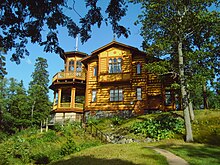Aino Ackté

Aino Ackté , actually Aino Achté (born July 23, 1876 in Helsinki , † August 8, 1944 in Vihti ) was a Finnish opera singer ( soprano ). A pioneer in the Finnish opera scene, the prima donna was the first to make her international breakthrough and performed in the most important opera houses around the world.
Life
Aino Achté was born in 1876 as the daughter of the mezzo-soprano Emmy Achté and the composer and conductor Lorenz Nikolai Achté . She learned to sing at an early age under the guidance of her mother, who had studied at the conservatories in Stockholm, Dresden and Paris. In 1894 Aino began a three-year course at the Paris Conservatory . She was taught there by, among others, Jean Jacques Masset (1811–1903), who had already taught her mother. It was during this time that her family name changed from Achté to Ackté .
In 1897 she made her debut at the Opéra National de Paris . Her portrayal of "Marguerite" in Charles Gounod's " Faust " was successful, which is why she was permanently employed at the opera for six years (until 1903). In her homeland there were rumors of a relationship with the painter Albert Edelfelt , who also created several portraits of her. However, in 1901 she married the lawyer, journalist and later politician Heikki Renvall , to whom she had been secretly engaged since 1896. On November 28, 1901, she gave birth to her first child, their daughter Glory , who later became known for her activities in film and theater. The marriage, which produced a son named Mies (becomes a gynecologist) in 1908, was divorced in 1917. Two years later she married Bruno Jalander , the landlord of Uusimaa and later Minister of Defense of Finland.
When her engagement in Paris ended in 1903, Aino Ackté signed a contract with the Metropolitan Opera in New York . However, the cultural differences and increased competition made it difficult for her to settle in, which is why she returned to Europe after two years, where she performed mainly in Covent Garden and other major stages in Great Britain and Germany over the next few years . Her repertoire included many Wagner operas such as " Die Meistersinger von Nürnberg ", " Lohengrin " (Elsa von Brabant), " Tannhäuser " (Elisabeth), " The Flying Dutchman " and " Siegfried ", but also Puccini's " Tosca " and Massenets " Thaïs ". Her favorite role and at the same time her greatest success was the portrayal of " Salome " in the opera of the same name by Strauss , under whose guidance she also rehearsed the role and presented it with great success for the first time in Covent Garden in 1910. At the world premiere of the tone poem Luonnotar (1913) by Jean Sibelius she sang the soprano solo.
With the beginning of the First World War she ended her international career and returned to Finland. Overall, her appearances became increasingly rare and in 1920 she gave her farewell appearance. She now turned her attention more to the organizational issues of the Finnish opera scene. In 1911 she founded the Finnish National Opera (“Suomen Kansallisooppera”, originally “Kotimainen Ooppera”) together with Oskar Merikanto and Edvard Fazer . In her role as director, she brought some glamor with her, but was not particularly popular with the artists, which is why she left the project after some disputes with the other founders. It was not until 1938 that she worked again as director, but resigned from her position a year later due to further arguments.
After leaving the “National Opera” project for the first time, she started organizing international festivals in the medieval Olavinlinna Castle in the Finnish city of Savonlinna . The event, then still called the Olavinlinna Opera Festival , took place under her direction in 1912, 1913, 1914, 1916 and after a long break in 1930. In 1930 she had her final public appearance as a singer at the Festival.
In August 1944, at the age of 68, she died in Vihti of a pancreatic tumor . A street was named after her in both Savonlinna and Helsinki. Her summer home in Helsinki, Villa Aino Ackté , is used by the city for cultural activities.
literature
- KJ Kutsch , Leo Riemens : Large singer lexicon . Unchanged edition. KG Saur, Bern, 1993, first volume A – L, column 6 f., ISBN 3-907820-70-3
- Outi Pakkanen : Aino Ackté. Pariisin primadonna. 1988, Söderström, Porvoo, ISBN 951-0-15224-2
- Pentti Savolainen, Matti Vainio (eds.): Aino Ackté - elämänkaari kirjeiden valossa. (Collection of letters) 2002, Söderstrom, Helsinki, ISBN 951-0-26381-8
- Pentti Savolainen: Rakkautta Pariisin taivaan alla. Aino Acktén yes Albert Edelfeltin tarina. 2002, Ajatus Kirjat, Helsinki, ISBN 951-20-6074-4
Web links
- Aino Ackté in the Internet Movie Database (English)
- Works by and about Aino Ackté in the catalog of the German National Library
- Audio samples in the Internet Archive
- Maarit Martin: The tigress of the world , Free Magazine
Individual evidence
- ↑ CD booklet for the recording with Vladimir Ashkenazy, Decca 1982. German text by an unnamed author.
| personal data | |
|---|---|
| SURNAME | Ackté, Aino |
| ALTERNATIVE NAMES | Achté, Aino (real name) |
| BRIEF DESCRIPTION | Finnish opera singer (soprano) |
| DATE OF BIRTH | July 23, 1876 |
| PLACE OF BIRTH | Helsinki |
| DATE OF DEATH | August 8, 1944 |
| Place of death | Vihti |

